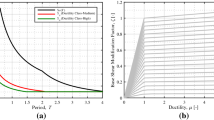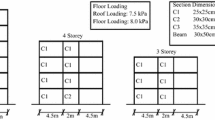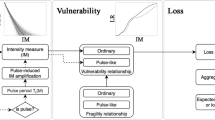Abstract
Probabilistic seismic risk is affected by several sources of uncertainty. Investigating their influence on loss analysis results is essential to obtain reliable quantitative estimations of seismic performance. Within the framework developed by the Pacific Earthquake Engineering Research (PEER) Center for probabilistic seismic loss analysis, this study incorporates the effect of seismic demand model class uncertainty on seismic risk performance metric estimation. The extended formulation is illustrated with an application example code-designed reinforced concrete moment resisting frame building with unreinforced masonry (URM) infill walls, where model class uncertainty related to URM infill walls modeling is propagated to the estimation of seismic financial losses. Model class uncertainty accounts for the variability arising from the use of different modeling solutions, such as the ones associated with the adoption of three equivalent strut macro-models and their modeling parameters. Probabilistic distributions are assigned to selected infill strut model parameters, and a large set of finite element models (FEMs) are generated for each infill strut model class by sampling the model parameter distributions through Latin Hypercube Sampling (LHS). Expected values of repair cost and life-cycle annualized loss are evaluated and compared for two sets of three building performance models. The first set considers the original (median) values of infill strut backbone parameters, while the second set includes model parameter uncertainty. The uncertainty propagation from structural response results to repair costs is also reported for the six performance models. Finally, the contribution of different structural and non-structural element categories to the financial losses is presented.











Similar content being viewed by others
References
ACI (2008) Building code requirements for structural concrete (ACI 318-08) and commentary. American Concrete Institute, Farmington Hills
Alam MS, Barbosa AR (2018) Probabilistic seismic demand assessment accounting for finite element model class uncertainty: application to a code-designed URM infilled reinforced concrete frame building. Earthq Eng Struct Dyn 47:2901–2920. https://doi.org/10.1002/eqe.3113
ASCE/SEI (2005) ASCE 7-05 minimum design loads for buildings and other structures. American Society of Civil Engineers, Reston
ASCE/SEI (2007) ASCE 41-06 seismic rehabilitation of existing buildings. American Society of Civil Engineers, Reston
ATC (2010) ATC 72-1: modeling and acceptance criteria for seismic design and analysis of tall buildings
Baker JW, Cornell CA (2006) Spectral shape, epsilon and record selection. Earthq Eng Struct Dyn 35:1077–1095. https://doi.org/10.1002/eqe.571
Baker JW, Cornell CA (2008) Vector-valued intensity measures incorporating spectral shape for prediction of structural response. J Earthq Eng 12:534–554. https://doi.org/10.1080/13632460701673076
Baradaran Shoraka M, Yang TY, Elwood KJ (2013) Seismic loss estimation of non-ductile reinforced concrete buildings. Earthq Eng Struct Dyn 42:297–310. https://doi.org/10.1002/eqe.2213
Barbosa AR (2011) Simplified vector-valued probabilistic seismic hazard analysis and probabilistic seismic demand analysis: application to the 13-story NEHRP reinforced concrete frame-wall building design example. UC San Diego, San Diego
Barbosa AR, Fahnestock LA, Fick DR et al (2017) Performance of medium-to-high rise reinforced concrete frame buildings with masonry in-fill in the 2015 Gorkha, Nepal, earthquake. Earthq Spect 33:S197–S218. https://doi.org/10.1193/051017EQS087M
Beck JL, Yuen K-V (2004) Model selection using response measurements: Bayesian probabilistic approach. J Eng Mech 130:192–203. https://doi.org/10.1061/(ASCE)0733-9399(2004)130:2(192)
Bovo M, Buratti N (2019) Evaluation of the variability contribution due to epistemic uncertainty on constitutive models in the definition of fragility curves of RC frames. Eng Struct 188:700–716. https://doi.org/10.1016/j.engstruct.2019.03.064
Bradley BA (2013) A critical examination of seismic response uncertainty analysis in earthquake engineering. Earthq Eng Struct Dyn 42:1717–1729. https://doi.org/10.1002/eqe.2331
Buratti N, Ferracuti B, Savoia M (2010) Response Surface with random factors for seismic fragility of reinforced concrete frames. Struct Saf 32:42–51. https://doi.org/10.1016/j.strusafe.2009.06.003
Burton H, Deierlein G (2014) Simulation of seismic collapse in nonductile reinforced concrete frame buildings with masonry infills. J Struct Eng 140:A4014016. https://doi.org/10.1061/(ASCE)ST.1943-541X.0000921
Cardone D, Perrone G (2015) Developing fragility curves and loss functions for masonry infill walls. Earthq Struct 9:257–279. https://doi.org/10.12989/eas.2015.9.1.257
Cardone D, Perrone G (2017) Damage and loss assessment of pre-70 RC frame buildings with FEMA P-58. J Earthq Eng 21:23–61. https://doi.org/10.1080/13632469.2016.1149893
Celarec D, Ricci P, Dolšek M (2012) The sensitivity of seismic response parameters to the uncertain modelling variables of masonry-infilled reinforced concrete frames. Eng Struct 35:165–177. https://doi.org/10.1016/j.engstruct.2011.11.007
Chen MC, Pantoli E, Wang X et al (2016) Full-scale structural and nonstructural building system performance during earthquakes: part I—specimen description, test protocol, and structural response. Earthq Spect 32:737–770. https://doi.org/10.1193/012414EQS016M
Chrysostomou CZ (1991) Effects of degrading infill walls on the nonlinear seismic response of two-dimensional steel frames. Cornell University, Ithaca
Conte JP, Zhang Y (2007) Performance based earthquake engineering: application to an actual bridge-foundation-ground system. In: 12th Italian national conference on earthquake engineering, ANIDIS, Pisa, June 10–14, 2007, pp 1–18
Cook D, Wade K, Haselton C et al (2018) A structural response prediction engine to support advanced seismic risk assessment. In: Proceedings of the 11th US national conference on earthquake engineering, Los Angeles, June 25–29
Crisafulli FJ (1997) Seismic behaviour of reinforced concrete structures with masonry infills. University of Canterbury, Christchurch
Crisafulli FJ, Carr AJ (2007) Proposed macro-model for the analysis of infilled frame structures. Bull New Zeal Soc Earthq Eng 40:69–77
Crowley H, Bommer JJ, Pinho R, Bird J (2005) The impact of epistemic uncertainty on an earthquake loss model. Earthq Eng Struct Dyn 34:1653–1685. https://doi.org/10.1002/eqe.498
Del Vecchio C, Di Ludovico M, Pampanin S, Prota A (2018) Repair costs of existing RC buildings damaged by the L’Aquila earthquake and comparison with FEMA P-58 predictions. Earthq Spect 34:237–263. https://doi.org/10.1193/122916EQS257M
Di Ludovico M, Prota A, Moroni C et al (2016) Reconstruction process of damaged residential buildings outside historical centres after the L’Aquila earthquake: part I—‘“light damage”’ reconstruction. Bull Earthq Eng 15:667–692. https://doi.org/10.1007/s10518-016-9979-3
Di Ludovico M, Prota A, Moroni C et al (2017) Reconstruction process of damaged residential buildings outside historical centres after the L’Aquila earthquake: part II—‘“heavy damage”’ reconstruction. Bull Earthq Eng 15:693–729. https://doi.org/10.1007/s10518-016-9979-3
Dolšek M (2009) Incremental dynamic analysis with consideration of modeling uncertainties. Earthq Eng Struct Dyn 38:805–825. https://doi.org/10.1002/eqe.869
Dolšek M, Fajfar P (2008) The effect of masonry infills on the seismic response of a four-storey reinforced concrete frame—a deterministic assessment. Eng Struct 30:1991–2001. https://doi.org/10.1016/j.engstruct.2008.01.001
El-Dakhakhni WW, Elgaaly M, Hamid AA (2003) Three-strut model for concrete masonry-infilled steel frames. J Struct Eng 129:177–185. https://doi.org/10.1061/(ASCE)0733-9445(2003)129:2(177)
Faggella M, Barbosa A, Conte JP et al (2008) Seismic assessment of R∕C building structure through nonlinear probabilistic analysis with high-performance computing. In: AIP conference proceedings. AIP, pp 930–936
Faggella M, Barbosa AR, Conte JP et al (2013) Probabilistic seismic response analysis of a 3-D reinforced concrete building. Struct Saf 44:11–27. https://doi.org/10.1016/j.strusafe.2013.04.002
FEMA (1998) FEMA 307: evaluation of earthquake damaged concrete and masonry wall buildings—technical resources. Federal Emergency Management Agency, Washington, DC
FEMA (2011) FEMA E-74: reducing the risks of nonstructural earthquake damage—a practical guide reducing the risks of nonstructural earthquake. Federal Emergency Management Agency, Washington, DC
FEMA (2012a) FEMA P-58-1: seismic performance assessment of buildings—methodology. Federal Emergency Management Agency, Washington, DC
FEMA (2012b) FEMA P-58-2: seismic performance assessment of buildings—implementation guide. Federal Emergency Management Agency, Washington, DC
Ferlito R, Guarascio M, Zucconi M (2013) Assessment of a vulnerability model against post-earthquake damage data: the case study of the historic city centre of L’Aquila in Italy. In: 9th world conference on earthquake resistant engineering structures. WIT transactions on the built environment, A Coruna, Spain, 8–10 July, pp 393–404. https://doi.org/10.2495/ERES130321
Ferracuti B, Savoia M, Zucconi M (2020) RC frame structures retrofitted by FRP-wrapping: a model for columns under axial loading and cyclic bending. Eng Struct 207:110243. https://doi.org/10.1016/j.engstruct.2020.110243
Franchin P, Lupoi A, Pinto PE, Schotanus MI (2003) Seismic fragility of reinforced concrete structures using a response surface approach. J Earthq Eng 7:45–77. https://doi.org/10.1080/13632460309350473
Gokkaya BU, Baker JW, Deierlein GG (2016) Quantifying the impacts of modeling uncertainties on the seismic drift demands and collapse risk of buildings with implications on seismic design checks. Earthq Eng Struct Dyn 45:1661–1683. https://doi.org/10.1002/eqe.2740
Goulet CA, Haselton CB, Mitrani-Reiser J et al (2007) Evaluation of the seismic performance of a code-conforming reinforced-concrete frame building—from seismic hazard to collapse safety and economic losses. Earthq Eng Struct Dyn 36:1973–1997. https://doi.org/10.1002/eqe.694
Hamburger RO, Rojahn C, Heintz JA, Mahoney MG (2012) FEMA P58 : next-generation building seismic performance assessment methodology. In: Proceedings of the 15th world conference on earthquake engineering, Lisboa, p 10
Haselton CB, Liel AB, Lange ST, Deierlein GG (2008) PEER report 2007/03: beam–column element model calibrated for predicting flexural response leading to global collapse of RC frame buildings. Pacific Earthquake Engineering Research Center College of Engineering University of California, Berkeley
Jalayer F (2003) Direct probabilistic seismic analysis: implementing non-linear dynamic assessments. Department of Civil and Environmental Engineering, Stanford University, Stanford
Jeon J-S, Park J-H, DesRoches R (2015) Seismic fragility of lightly reinforced concrete frames with masonry infills. Earthq Eng Struct Dyn 44:1783–1803. https://doi.org/10.1002/eqe.2555
Kappos AJ, Chryssanthopoulos MK, Dymiotis C (1999) Uncertainty analysis of strength and ductility of confined reinforced concrete members. Eng Struct 21:195–208. https://doi.org/10.1016/S0141-0296(97)00181-8
Karthik MM, Mander JB (2011) Stress-block parameters for unconfined and confined concrete based on a unified stress–strain model. J Struct Eng 137:270–273. https://doi.org/10.1061/(ASCE)ST.1943-541X.0000294
Kohrangi M, Bazzurro P, Vamvatsikos D (2016) Vector and scalar IMs in structural response estimation, part II: building demand analysis. Earthq Spectra 32:1525–1543. https://doi.org/10.1193/053115EQS081M
Kohrangi M, Vamvatsikos D, Bazzurro P (2016) Implications of intensity measure selection for seismic loss assessment of 3-D buildings. Earthq Spectra 32:2167–2189. https://doi.org/10.1193/112215EQS177M
Koutromanos I, Stavridis A, Shing PB, Willam K (2011) Numerical modeling of masonry-infilled RC frames subjected to seismic loads. Comput Struct 89:1026–1037. https://doi.org/10.1016/j.compstruc.2011.01.006
Kwon O-S, Elnashai A (2006) The effect of material and ground motion uncertainty on the seismic vulnerability curves of RC structure. Eng Struct 28:289–303. https://doi.org/10.1016/j.engstruct.2005.07.010
Liel AB, Haselton CB, Deierlein GG, Baker JW (2009) Incorporating modeling uncertainties in the assessment of seismic collapse risk of buildings. Struct Saf 31:197–211. https://doi.org/10.1016/j.strusafe.2008.06.002
Lin T, Haselton CB, Baker JW (2013) Conditional spectrum-based ground motion selection. Part I: hazard consistency for risk-based assessments. Earthq Eng Struct Dyn 42:1847–1865. https://doi.org/10.1002/eqe.2301
McKenna F, Scott MH, Fenves GL (2010) Nonlinear finite-element analysis software architecture using object composition. J Comput Civ Eng 24:95–107. https://doi.org/10.1061/(ASCE)CP.1943-5487.0000002
Mehrabi AB, Shing PB, Schuller MP, Noland JL (1994) Performance of masonry-infilled R/C frames under in-plane lateral loads. Technical report CU/SR-94/6, University of Colorado at Boulder, Boulder
Moehle J, Deierlein GG (2004) A framework methodology for performance-based earthquake engineering. In: Proceedings of the 13th world conference on earthquake engineering, Vancouver
Mohammad AF, Faggella M, Gigliotti R, Spacone E (2014) Probabilistic seismic response sensitivity of nonlinear frame bending-shear and infill model parameters for an existing infilled reinforced concrete structure. In: Proceedings of the 12th international conference on computational structures technology, Naples, pp 1–9
Mohammad AF, Faggella M, Gigliotti R, Spacone E (2016) Seismic performance of older R/C frame structures accounting for infills-induced shear failure of columns. Eng Struct 122:1–13. https://doi.org/10.1016/j.engstruct.2016.05.010
Mohammed MA, Yu H, Furtado A et al (2017) Post-earthquake field measurement-based system identification and finite element modeling of an 18-story masonry-infilled RC building. In: International conference on experimental vibration analysis for civil engineering structures. Springer, Berlin, pp 746–757
Mohammad AF, Faggella M, Gigliotti R, Spacone E (2018) Effects of bond-slip and masonry infills interaction on seismic performance of older R/C frame structures. Soil Dyn Earthq Eng 109:251–265. https://doi.org/10.1016/j.soildyn.2018.02.027
Molina Hutt C, Rossetto T, Deierlein GG (2019) Comparative risk-based seismic assessment of 1970s vs. modern tall steel moment frames. J Constr Steel Res 159:598–610. https://doi.org/10.1016/j.jcsr.2019.05.012
Muratovic A, Ademovic N (2015) Influence of masonry infill on reinforced concrete frame structures’ seismic response. Coupled Syst Mech 4:173–189. https://doi.org/10.12989/csm.2015.4.2.173
Muto M, Beck JL (2008) Bayesian updating and model class selection for hysteretic structural models using stochastic simulation. J Vib Control 14:7–34. https://doi.org/10.1177/1077546307079400
Panagiotou M, Restrepo JI (2007) Lessons learnt from the UCSD full-scale shake table testing on a 7-story residential building slice. In: Proceedings of SEAOC convention, Squaw Creek, pp 57–73
Pantoli E, Chen MC, Wang X et al (2016) Full-scale structural and nonstructural building system performance during earthquakes: Part II—NCS damage states. Earthq Spect 32:771–794. https://doi.org/10.1193/012414EQS017M
Paulay T, Priestly MJN (1992) Seismic design of reinforced concrete and masonry buildings. Wiley, Hoboken
Porter KA (2003) An overview of PEER’s performance-based earthquake engineering methodology. In: 9th international conference on applications of statistics and probability in civil engineering, San Francisco, July 6–9, pp 973–980
Ramirez CM, Liel AB, Mitrani-Reiser J et al (2012) Expected earthquake damage and repair costs in reinforced concrete frame buildings. Earthq Eng Struct Dyn 41:1455–1475. https://doi.org/10.1002/eqe.2216
Ramirez CM, Miranda E (2009) Building-specific loss estimation methods & tools for simplified performance-based earthquake engineering. Report No 171, May 2009, The John A. Blume Earthquake Engineering Center, Department of Civil and Environmental Engineering Stanford University
Ramirez CM, Miranda E (2012) Significance of residual drifts in building earthquake loss estimation. Earthq Eng Struct Dyn 41:1477–1493. https://doi.org/10.1002/eqe.2217
Romano F, Faggella M, Gigliotti R et al (2018) Comparative seismic loss analysis of an existing non-ductile RC building based on element fragility functions proposals. Eng Struct 177:707–723. https://doi.org/10.1016/j.engstruct.2018.08.005
Romano F, Alam M, Faggella M et al (2019a) Seismic loss analysis of a modern RC building accounting for uncertainty of infill strut modeling parameters. In: Proceedings of the 7th international conference computational mechanics and structural dynamics earthquake engineering (COMPDYN 2019), pp 2094–2102. https://doi.org/10.7712/120119.7061.19445
Romano F, Zucconi M, Ferracuti B (2019b) Seismic fragility curves for RC buildings at territorial scale. In: Proceedings of the 7th international conference computational mechanics and structural dynamics earthquake engineering (COMPDYN 2019), pp 1719–1730. https://doi.org/10.7712/120119.7031.19415
Rota M, Penna A, Strobbia CL (2008) Processing Italian damage data to derive typological fragility curves. Soil Dyn Earthq Eng 28:933–947. https://doi.org/10.1016/j.soildyn.2007.10.010
Saneinejad A, Hobbs B (1995) Inelastic design of infilled frames. J Struct Eng 121:634–650
Sattar S, Liel AB (2010) Seismic performance of reinforced concrete frame structures with and without infill walls. In: 9th US national and 10th Canadian conference on earthquake engineering, Toronto
Scott MH, Fenves GL (2006) Plastic hinge integration methods for force-based beam–column elements. J Struct Eng 132:244–252. https://doi.org/10.1061/(ASCE)0733-9445(2006)132:2(244)
Scott BD, Park R, Priestley MJN (1982) Stress–strain behavior of concrete confined by overlapping hoops at low and high strain rates. ACI J Proc 79:13–27
Şengezer B, Ansal A (2007) Probabilistic evaluation of observed earthquake damage data in Turkey. Nat Hazards 40:305–326. https://doi.org/10.1007/s11069-006-0016-8
Shome N, Cornell CA, Bazzurro P, Carballo JE (1998) Earthquakes, records, and nonlinear responses. Earthq Spect 14:469–500. https://doi.org/10.1193/1.1586011
Smyrou E, Blandon C, Antoniou S et al (2011) Implementation and verification of a masonry panel model for nonlinear dynamic analysis of infilled RC frames. Bull Earthq Eng 9:1519–1534. https://doi.org/10.1007/s10518-011-9262-6
Sousa L, Silva V, Marques M, Crowley H (2018) On the treatment of uncertainty in seismic vulnerability and portfolio risk assessment. Earthq Eng Struct Dyn 47:87–104. https://doi.org/10.1002/eqe.2940
Stavridis A (2009) Analytical and experimental study of seismic performance of reinforced concrete frames infilled with masonry walls. University of California, San Diego
Stavridis A, Koutromanos I, Shing PB (2012) Shake-table tests of a three-story reinforced concrete frame with masonry infill walls. Earthq Eng Struct Dyn 41:1089–1108. https://doi.org/10.1002/eqe.1174
Terzic V, Schoettler MJ, Restrepo JI, Mahin SA (2015) Concrete column blind prediction contest 2010: outcomes and observations. PEER Rep 1:1–145
Tubaldi E, Barbato M, Dall’Asta A (2012) Influence of model parameter uncertainty on seismic transverse response and vulnerability of steel-concrete composite bridges with dual load path. J Struct Eng 138:363–374. https://doi.org/10.1061/(ASCE)ST.1943-541X.0000456
Tucker BE (2004) Trends in global urban earthquake risk: a call to the international Earth Science and Earthquake Engineering communities. Seismol Res Lett 75:695–700
Varum H, Dumaru R, Furtado A et al (2018) Seismic performance of buildings in nepal after the gorkha earthquake. In: Impacts and insights of gorkha earthquake in Nepal. Elsevier, London, pp 47–63
Yassin MHM (1994) Nonlinear analysis of prestressed concrete structures under monotonic and cyclic loads. University of California, Berkeley
Zucconi M, Bovo M, Romano F, Ferracuti B (2020a) Application of bidirectional ground motion on existing RC building for seismic loss analysis. ICNAAM 2019—17th international conference of numerical analysis and applied mathematics, pp 1–4
Zucconi M, Ferlito R, Sorrentino L (2020b) Validation and extension of a statistical usability model for unreinforced masonry buildings with different ground motion intensity measures. Bull Earthq Eng 18:767–795. https://doi.org/10.1007/s10518-019-00669-2
Acknowledgements
The first, the third, and the last author wish to acknowledge the financial support received by the Italian Department of Civil Protection (ReLUIS Grant—Reinforced Concrete Structures). Support from Oregon State University to the first author during the time he spent at Oregon State University when developing the work presented here is also acknowledged. The second and fifth authors would like to acknowledge that part of the funding for this study was provided as part of the cooperative agreement 70NANB15H044 between the National Institute of Standards and Technology (NIST) and Colorado State University through a subaward to Oregon State University. The content expressed in this paper are the views of the authors and do not necessarily represent the opinions or views of NIST or the US Department of Commerce. Authors also acknowledge the support received by the Haselton Baker Risk Group for helping to perform the seismic performance analysis through the SP3 web-tool educational license acquired through Oregon State University.
Author information
Authors and Affiliations
Corresponding author
Additional information
Publisher's Note
Springer Nature remains neutral with regard to jurisdictional claims in published maps and institutional affiliations.
Appendix
Appendix
This appendix reports in detail the 245 unique GM records used for the three numerical models and the different HLs introduced in Sect. 3.1. In particular, Table 4 associates a number to each selected HL and reports the spectral accelerations at the conditioning period for the three building models, \({S}_{a}({T}_{1})\) at each HL.
The HLs numbering in Table 4 is introduced for clear correspondence of the HLs in Table 5, shown here below. This table lists the 245 unique GMs, in particular each line reports the record file name together with the HLs and numerical models for which that GM is selected. The record scale factors vary from 0.26 to 4 and are not reported in the table for brevity.
Rights and permissions
About this article
Cite this article
Romano, F., Alam, M.S., Zucconi, M. et al. Seismic demand model class uncertainty in seismic loss analysis for a code-designed URM infilled RC frame building. Bull Earthquake Eng 19, 429–462 (2021). https://doi.org/10.1007/s10518-020-00994-x
Received:
Accepted:
Published:
Issue Date:
DOI: https://doi.org/10.1007/s10518-020-00994-x




